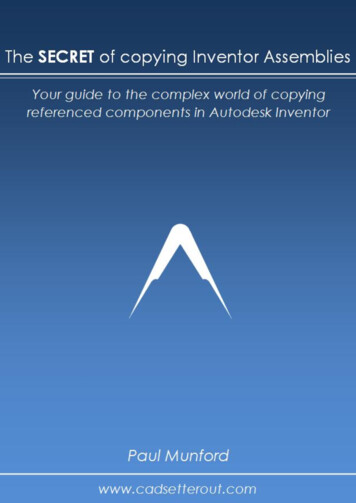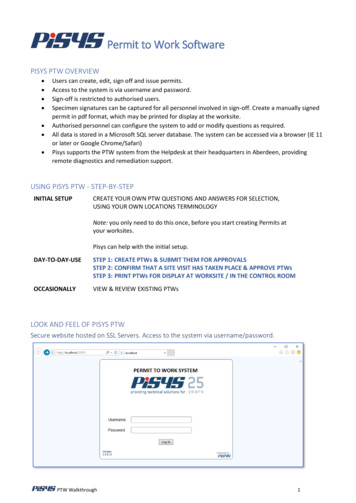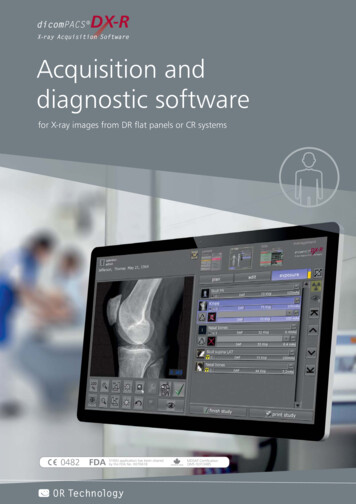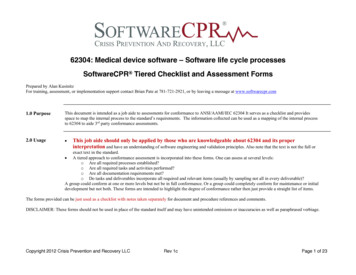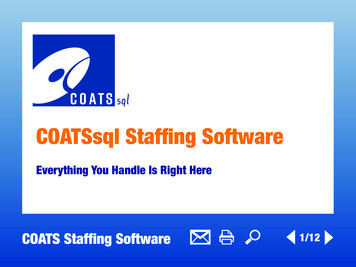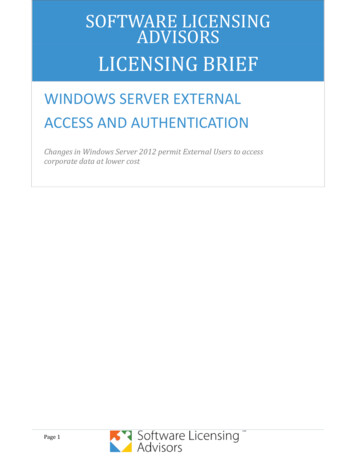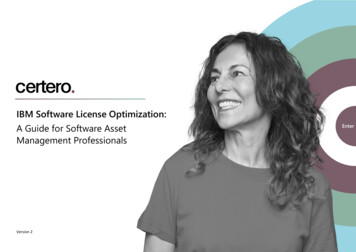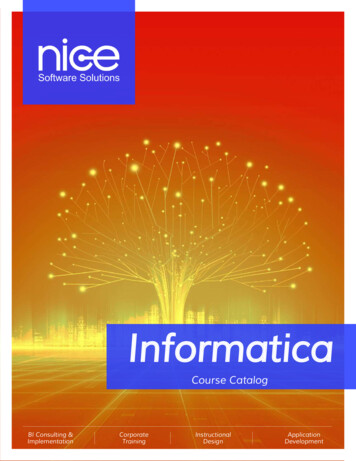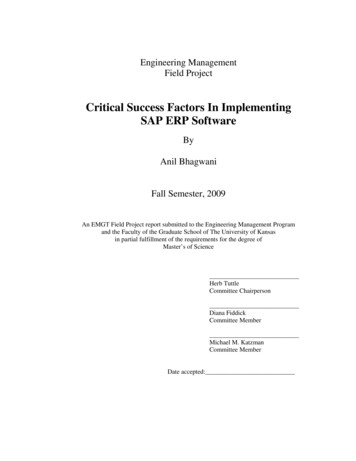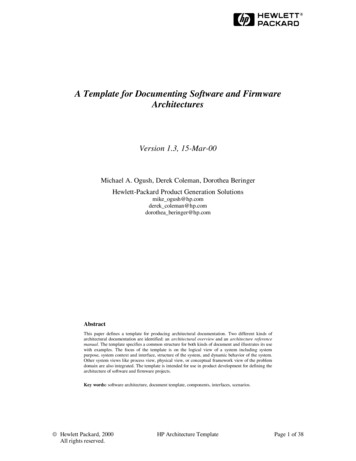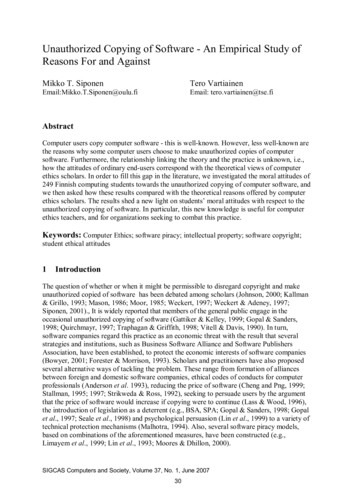
Transcription
Unauthorized Copying of Software - An Empirical Study ofReasons For and AgainstMikko T. SiponenTero VartiainenEmail:Mikko.T.Siponen@oulu.fiEmail: tero.vartiainen@tse.fiAbstractComputer users copy computer software - this is well-known. However, less well-known arethe reasons why some computer users choose to make unauthorized copies of computersoftware. Furthermore, the relationship linking the theory and the practice is unknown, i.e.,how the attitudes of ordinary end-users correspond with the theoretical views of computerethics scholars. In order to fill this gap in the literature, we investigated the moral attitudes of249 Finnish computing students towards the unauthorized copying of computer software, andwe then asked how these results compared with the theoretical reasons offered by computerethics scholars. The results shed a new light on students’ moral attitudes with respect to theunauthorized copying of software. In particular, this new knowledge is useful for computerethics teachers, and for organizations seeking to combat this practice.Keywords: Computer Ethics; software piracy; intellectual property; software copyright;student ethical attitudes1IntroductionThe question of whether or when it might be permissible to disregard copyright and makeunauthorized copied of software has been debated among scholars (Johnson, 2000; Kallman& Grillo, 1993; Mason, 1986; Moor, 1985; Weckert, 1997; Weckert & Adeney, 1997;Siponen, 2001)., It is widely reported that members of the general public engage in theoccasional unauthorized copying of software (Gattiker & Kelley, 1999; Gopal & Sanders,1998; Quirchmayr, 1997; Traphagan & Griffith, 1998; Vitell & Davis, 1990). In turn,software companies regard this practice as an economic threat with the result that severalstrategies and institutions, such as Business Software Alliance and Software PublishersAssociation, have been established, to protect the economic interests of software companies(Bowyer, 2001; Forester & Morrison, 1993). Scholars and practitioners have also proposedseveral alternative ways of tackling the problem. These range from formation of alliancesbetween foreign and domestic software companies, ethical codes of conducts for computerprofessionals (Anderson et al. 1993), reducing the price of software (Cheng and Png, 1999;Stallman, 1995; 1997; Strikweda & Ross, 1992), seeking to persuade users by the argumentthat the price of software would increase if copying were to continue (Lass & Wood, 1996),the introduction of legislation as a deterrent (e.g., BSA, SPA; Gopal & Sanders, 1998; Gopalet al., 1997; Seale et al., 1998) and psychological persuasion (Lin et al., 1999) to a variety oftechnical protection mechanisms (Malhotra, 1994). Also, several software piracy models,based on combinations of the aforementioned measures, have been constructed (e.g.,Limayem et al., 1999; Lin et al., 1993; Moores & Dhillon, 2000).SIGCAS Computers and Society, Volume 37, No. 1, June 200730
Studies exploring the underlying reasons why people regard the unauthorized copying ofcomputer software as morally unacceptable or acceptable are few (Cheng et al., 1997;Lending and Slaughter, 1999; Thong & Yap, 1998). The aforementioned software piracymodels (e.g., Limayem et al., 1999), developed on the basis of the behavioural literature(such as Fishbein & Ajzen, 1975; Ajzen, 1991), do not reveal individuals’ underlying moralreasons (Loch & Conger, 1996; Randall, 1989; Thong & Yap, 1998). The same is true forquantitative questionnaires, such as (Simpson et al., 1994).Only two studies, by Cheng et al. (1997) and Seale et al. (1998) explore user rationalesconcerning the unauthorized copying of software, and neither was conducted in Europe.Moreover, given the long history of theories and the theoretical debate about software rights(e.g., see Johnson, 2000; Kuflik, 1995; Ladd, 1997; Siponen, 2001; Thong & Yap, 1998;Weckert, 1997; Weckert & Adeney, 1997), it is notable that as yet there has been no work(excluding Thong & Yap, 1998) exploring the relationship between the views in theliterature on the ethical theory and how people really behave in practice. Such studies ofordinary users’ moral attitudes are important for computer ethics education (Sumner &Werner, 1997) and for the development of methods to tackle the problem. As far ascomputer ethics education is concerned, it is crucial to perceive the match or non-matchbetween theory and practice. To address the gap in the existing research, we analyzed thesurvey responses of 249 computing students’ concerning their moral attitudes towards theunauthorized copying of computer software, and we explored how these answers comparedwith the attitudes suggested by computer ethics scholars.In the second section of this paper, related studies and their respective theoreticalfoundations are discussed. In the third section, the research approach and research subjectsare described. In the fourth section, the results of the study are presented. The fifth section,the discussion, considers the limitations as well as implications of the study. Finally, theconclusion summarizes the key findings of the study.2Theoretical reasons for disregarding copyrightThe reasons for unauthorized copying of software can be found in the literature as listed belowin Table 1.Table 1. Reasons why copying of computer software is morally acceptable.ReasonRelevant source/sSoftware is intangibleand/or non-exclusiveEveryone does itIt is so easy to copysoftwareKuflick (1995), Ladd (1997), Weckert (1997), Weckert andAdeney (1997)Langford (1995), Baase (1997)Weisband and Goodman (1992); Langford (1995)It doesn’t harm anyoneThe low quality of softwareStallman (1995), see also Weckert (1997), Weckert and Adeney(1997)Takeyama (2002)Software is expensiveWeisband and Goodman (1992) and Baase (1997))The risk of being caught isminimalCheng et al. (1997) and Langford (1995).SIGCAS Computers and Society, Volume 37, No. 1, June 200731
The reasons listed in this table are discussed in the literature of Computer Ethics, along thelines set out below.The non-exclusive nature of software has recently been offered as a morally acceptable reasonfor the unauthorized copying of software. According to this argument, software cannot bebound by ownership or copyright, because software products are immaterial products. Such aview is adopted by (Kuflick, 1995; Ladd, 1997; Weckert, 1997: Weckert & Adeney, 1997).While scholars regard the reason “everyone else does it” as morally unacceptable, this reasonhas been discussed in the literature as a potential reason for copying software (Langford,1995).The same goes for the argument “it is so easy to copy software” that is also mentioned inliterature as a potential reason for copying software (Langford, 1995; Nissenbaum, 1995;Weisband & Goodman, 1992). This line of argument has also found significant empiricalsupport (Cheng et al., 1997; Weisband & Goodman, 1992).The argument that the unauthorized copying of software does not do any harm to anyone isput forward by Ladd (1997), Nissenbaum (1995), Stallman (1995; 1997) (see also Weckert,1997; Weckert & Adeney, 1997). They argue, for instance, that software copying does notharm anyone as the person copying software does not take anything from the owner. Theymaintain that by making electronic copies the owner of the software still has the software,despite the fact that others have it as well.The high cost of software is reported to be one crucial reason why ordinary people tend tocopy software (Cheng et al., 1997; Weisband & Goodman, 1992).The argument about the low quality of software (“the quality of software is so bad that it isnot worth paying for”) is based on the idea that consumers have reservations about the qualityof software products (Takeyama, 2002).The small risk of being caught copying unauthorized software (“although it may be forbiddenby law, the risk of getting caught is negligible“) is seen to be a major factor behind thepractice (Cheng et al., 1997; Langford, 1995).These seven reasons were used as a basis for studying students’ reasons for the unauthorizedcopying of software.3Research approach and research subjectsTo study these research problems empirically, a quantitative and a qualitative questionnairewere administrated. Questionnaires were given to the students on three courses at a Finnishuniversity. Two of the three courses (1 and 2) were organized by the Department ofInformation Processing Science in the Faculty of Natural Sciences and one by the Departmentof Electronic Engineering at the Faculty of Technology (course 3). Course 3, given by theDepartment of Electronic Engineering, a UNIX course, is compulsory for all students of theFaculty of Technology in order for them to get an email account. Course 1 was an OpenUniversity course. Course 1 consisted of 33 people, of whom over half were men (72.7 %). Incourse 2, 28.3 % of the 106 participants were males. In case of course 3, there were 110SIGCAS Computers and Society, Volume 37, No. 1, June 200732
participants, of whom 94.5 % were men and 4.5 were women. In total 249 students filled inthe questionnaires.The anonymous questionnaire was preferred by the researchers over open interviews. Thisdecision was made since open interviews are argued to be an unreliable method of studyingthe question of unauthorized copying of software owing to its sensitivity (Lin et al., 1997).When handing out the questionnaires to students, it was stressed that the students’ identitywould not be revealed under any circumstances. For example, it was said to the students thatthe person analyzing the results had no connection with the course in which the questionnairewas handed out. The questions presented to the students are described in Table 2.Table 2: The questionnaire1. The unauthorized copying of software is acceptable because:Software is expensiveEveryone else does itIt is easyAlthough it may be forbidden by law, the risk of getting caught is negligibleThe quality of software is so bad that it is not worth paying forSoftware cannot be bound by ownership or copyright,because software products are immaterial productsIt doesn’t do any harm to anyoneOther reason , which is:Does the act of copying focus on the products of a specific software companyYesNoIf your earned income were dependent on software development, would it change your viewpointconcerning unauthorized copying of software?YesNo2. It is not acceptable because:The act is illegalThe act is immoralOther reason , which is:I have made illegal copies of software and I still do it/may continue to do it, although I don’t consider itacceptable , because:The first question asked why it is acceptable to copy software, and the respondents wereasked to tick the relevant answer, or write another reason if their preferred justification wasnot mentioned in the questionnaire. It was also asked, whether the act was focused on theproducts of a specific software company and whether if the respondents earned income weredependent on software business assuming it would change the respondents’ viewpointconcerning the acceptability of the unauthorized copying of software.SIGCAS Computers and Society, Volume 37, No. 1, June 200733
Alternatively, in the second question in Table 2, the respondents were asked to tick therelevant answer as to why they regarded copying as unacceptable (illegal or immoral). Thequestion “I have made illegal copies of software and I still do it/may continue to do it,although I don’t consider it acceptable ” explores whether the respondents have conductedunauthorized copying, even where, they perceive the act as morally unacceptable.Percentage calculation was conducted on respondents’ selections and the interpretive contentanalysis approach by Lacity and Janson (1994, p. 148) was utilized to analyze the textualresponses. In using this approach the contextual circumstances in which respondents frametheir answers and the circumstances that influence researchers’ interpretations are taken intoaccount. The results of the questionnaire are presented next.4The results of the study4.1 Reasons found in literature vs. survey respondents’ reasonsThe respondents selected their reason for unauthorized copying of software (cf., Table 2).Table 3 illustrates the relative distribution of reasons given in favour of the unauthorizedcopying of software.Table 3. Distribution of reasons given for the unauthorized copying of software.RationalesExpensiveMinimum riskIt is easyEveryone else does itOther reasonsIt doesn’t do any harm to anyoneLow qualitySoftware cannot be bound by ownership or he argument that “software is expensive” was the most popular answer: it was given by58.2 % of respondents. The argument “although it may be forbidden by law, the risk ofgetting caught is negligible” came in second place at 23.3 %.The reason that copying “is so easy” was supported by 16.5 % of our respondents.The argument “everyone else does it, too” was considered by 14.5 % of the respondents as aproper reason for copying software. 12.0 % of our respondents gave other reasons forcopying unauthorized software (see qualitative results in section 4.2.1).The argument that the unauthorized copying of software doesn’t do any harm to anyone washeld by 9.6 % of our respondents.Only 6.8 % of our respondents saw that “the quality of software is so bad that it is not worthpaying for” as a relevant reason for copying unauthorized software.The argument put forward by computer ethics scholars (Kuflik, 1995; Stallman, 1995; 1997;Weckert, 1997; Weckert & Adeney, 1997) that “software cannot be bound by ownership orcopyright, because software products are immaterial products” was the least favorableSIGCAS Computers and Society, Volume 37, No. 1, June 200734
rationale for regarding unauthorized copying as morally acceptable. Only 2.4 % ofrespondents considered this to be a reason for copying software.Tho
software companies regard this practice as an economic threat with the result that several strategies and institutions, such as Business Software Alliance and
